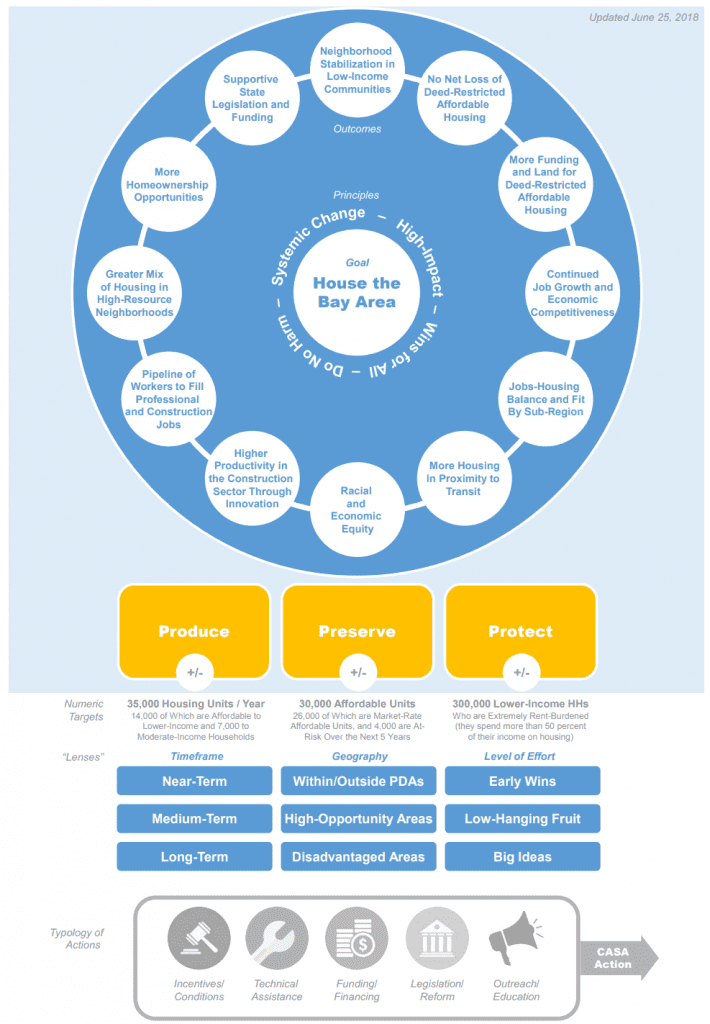The new climate economy is defined by statistics like widening wealth gaps, rising costs of non CPI goods such as food, energy, and housing, the built environment’s draw on global resources, contamination of our oceans, and ineffective global policy decisions. But more and more, it’s about urban growth as droves of people flock to cities. How we grow is very much still up for debate, but there is almost unanimous opinion that density, as opposed to sprawl, is the best route for the climate and the economy.
Zooming in on cities, last year Stok attended a panel on housing where Up For Growth stated that in 2017, 5.3 million households (41% of California’s total households) were cost-burdened, paying more than 30% of their incomes on housing while more than 134,000 people were homeless across the state—a 16% increase over 2015 (Up For Growth). In fact, from 2000 to 2015, California underproduced housing by approximately 3.4 million units, more than 15% of the state’s total 2015 housing stock (Up For Growth).
Reacting to this confluence of forces and data points, ULI saw the need for a local discussion. In its third year, Housing the Bay drills into the “impossibility of living in the Bay Area without being impacted in some way by the high cost and limited supply of housing.” Not surprisingly, it features the intricate intersection of urban planning, urban history, architecture, economics, environmentalism, and research.
Whether you’re a renter, homeowner, employer, or government, the issue of housing unaffordability has already affected you. Here’s what to know about the state of the housing crisis and the leaders bringing actionable solutions to the table.
THE STATE OF THE HOUSING CRISIS
The Bay Area may appear as the pinnacle of the housing crisis, but nationally, it’s just as bad. Of the 1.4 million units of housing the U.S. has produced in the last 10 years (roughly 140K annually), only 38K of them have not been Class A projects (Scott Muldavin Research). Add today’s B+ properties into the mix and we’re building well over 80% of new housing for less than 30% of the population.

Source: Yardi Matrix
The combination of underdevelopment of housing overall (supply and demand laws ensure that increases in supply will reduce the market price, all things equal) and the exacerbated undersupply of middle income housing translates to 1 in 3 Americans being economically insecure. That economic insecurity necessitates borrowing for all sorts of things, from student debt, to mortgage debt, to credit card debt, to car loan debt.
FAILING TO ACT IN CALIFORNIA
This should have been the loud siren beckoning the need for transit oriented, middle income housing, but it wasn’t. Instead, SB 50 was shelved in May, failing to incentivize mid-rise apartment construction in transit and job hubs.
“Powerful interests lined up behind Senate Bill 50, a proposal in the California Legislature to dramatically increase home building near mass transit and in neighborhoods zoned only for single-family homes. On board were labor and business groups, environmentalists and developers, students and retirees, all of whom argued that radical change was necessary to solve the state’s housing affordability crisis.”
While Scott Wiener and the YIMBYs were challenged in the suburbs, they’ve remained optimistic about SB 50s chances, as it dovetails with efforts by the CASA Compact. Beyond literally meaning “house” in Spanish, CASA is the name of a blue-ribbon task force of elected and civic leaders convened by the Metropolitan Transportation Commission (MTC) and the Association of Bay Area Governments (ABAG) for a series of structured discussions with local government officials, developers, major employers, labor interest groups, housing and policy experts, social equity advocates, and non-profit housing providers.
Their goal is straightforward but by no means simple: “find common ground on a comprehensive set of solutions to the Bay Area’s housing crisis.” They view this housing crisis as a failure in three parts: (1) failure to produce enough housing for residents at all income levels; (2) failure to preserve the affordable housing that already exists; and (3) failure to protect current residents from displacement where neighborhoods are rapidly changing. CASA’s proposed solution is similarly three-pronged, focusing on three Ps: Production, Preservation, and Protection.

Source: CASA Compact
Yet despite the simplicity in their mission, the multidisciplinary stakeholder process, and 18 months of deliberation, some small Bay Area cities felt they didn’t get a seat at the table and have pushed back on the plan, forcing some retooling from the group. It seems when it comes to housing policy, we can’t all be Minneapolis.
TECH OFFERS UP SOLUTIONS
While policy has lagged, technology startups are developing solutions by ramping up their focus on simultaneously increasing the housing supply and increasing construction productivity.
Recently, new technologies like Katerra, FactoryOS, and SoCo joined existing players in the modular space such as RAD Urban. SoCo might be the most disruptive of them all. Focused exclusively on the rental housing market, they’re manufacturing a ‘smart wainscoting’ for interior walls. While at first that doesn’t sound like a market mover, the system solves for the majority of cost of construction, which comes from labor and MEP.
The progress from technology companies is timely and much needed, as big corporate has suddenly entered the arena. Kaiser, Facebook, and Google just dived into the housing issue head first. Unlikely participants who undoubtedly aren’t building for their employees due to FHA law, they likely see the macro risk of inaction as greater than the costs. For Kaiser it’s undoubtedly part of the larger theme around healthy individuals and thriving communities. For both of those to happen, the lower levels of Maslow’s Hierarchy must be met, including stable housing.
Tech solutions have arisen in the existing building stock too. Tyrone Poole, founder of OneApp, decided to launch an app after undergoing a horrific housing search including months in the hospital where he was when he got evicted. Today, OneApp connects underqualified renters to units where they have a higher chance of being approved. It turns out every landlord has their own screening criteria and even knowing that criteria before applying removes significant barriers between renters and housing units.
THE RISE OF COLIVING
In parallel to tech solutions in the existing market, coliving offers a social solution that restructures our basic assumptions about housing. While we know there isn’t a one size fits all strategy to solving the housing crisis, several companies are now focused on trying to get renters to live together. It’s a lot like co-working but more intimate. Tenants in a typical coliving arrangement each have their own lease, covering their bedroom and shared spaces in a group suite. By densifying these buildings, coliving developments put more units within the same spatial footprint than you’d find in a typical apartment property. Not surprisingly, several housing champions in attendance at ULI Housing the Bay were coliving operators and developers.
“Coliving is not a temporary ‘experiment’, rather a housing alternative that satisfies the wants and needs of today’s and tomorrow’s residential tenants. It is here to stay.”
-Ric Russell, Executive Managing Director, Cushman & Wakefield Bay Area Capital Markets
Ric and the Cushman & Wakefield team put together a recent report on the coliving market, while JLL published their own version late last year. Both outline the same need from coastal cities and nationwide, as well as provide the underpinning of “why this movement” and “why now.”
Beyond capitalizing on density and construction efficiency, coliving also better services the renter generation. Given this growing population’s not only willingness, but preference, to share, borrow, and rent, coliving is rising as a desirable alternative to typical housing solutions in the Bay Area and worldwide.
WHAT CAN WE DO ABOUT IT?
Between complex, collaborative policy, innovative technology, and new approaches to our accepted housing norms through coliving, the housing crisis is slowly on its way to a solution. But there’s still much work to be done—and urgently. If you’re interested in tackling housing supply and affordability, get in touch and let’s bring about solutions together.



